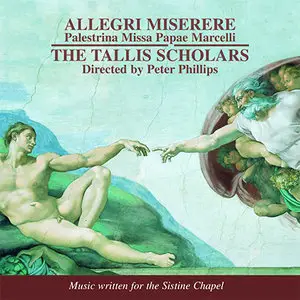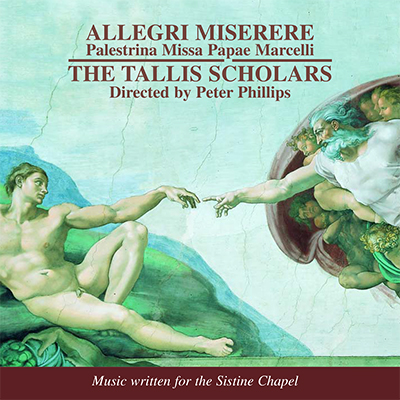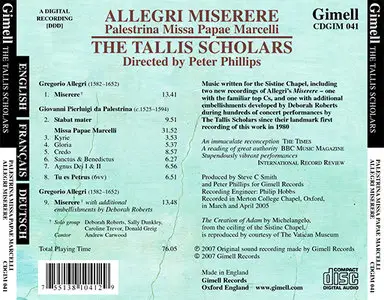The Tallis Scholars - Music written for the Sistine Chapel
Allegri: Miserere & Palestrina: Missa Papae Marcelli
EAC+LOG+CUE | FLAC: 358 MB | Artwork | 5% Recovery Info
Label/Cat#: Gimell Records # CDGIM 041 | Country/Year: UK 2007
Genre: Classical | Style: Renaissance, Choral, Sacred
MD5 [X] CUE [X] LOG [X] INFO TEXT [X] ARTWORK [X]
my rip [ ] not my rip [X]
EAC extraction logfile from 30. May 2007, 14:22 for CD
The Tallis Scholars, Peter Phillips / Music written for the Sistine Chapel
Used drive : HL-DT-STDVDRAM GSA-4165B Adapter: 0 ID: 1
Read mode : Secure with NO C2, accurate stream, disable cache
Read offset correction : 667
Overread into Lead-In and Lead-Out : No
Used output format : C:\Archivos de programa\FLAC\flac.exe (User Defined Encoder)
Other options :
Fill up missing offset samples with silence : Yes
Delete leading and trailing silent blocks : No
Installed external ASPI interface
Range status and errors
Selected range
Filename H:\SonusTerrae Publicaciones\Music written for the Sistine Chapel_Tallis Scholars (Gimell 2007)_Flac_booklet (ST)\The Tallis Scholars, Peter Phillips - Music written for the Sistine Chapel.wav
Peak level 98.8 %
Range quality 100.0 %
CRC E23202B1
Copy OK
No errors occured
End of status report
The Tallis Scholars, Peter Phillips / Music written for the Sistine Chapel
Used drive : HL-DT-STDVDRAM GSA-4165B Adapter: 0 ID: 1
Read mode : Secure with NO C2, accurate stream, disable cache
Read offset correction : 667
Overread into Lead-In and Lead-Out : No
Used output format : C:\Archivos de programa\FLAC\flac.exe (User Defined Encoder)
Other options :
Fill up missing offset samples with silence : Yes
Delete leading and trailing silent blocks : No
Installed external ASPI interface
Range status and errors
Selected range
Filename H:\SonusTerrae Publicaciones\Music written for the Sistine Chapel_Tallis Scholars (Gimell 2007)_Flac_booklet (ST)\The Tallis Scholars, Peter Phillips - Music written for the Sistine Chapel.wav
Peak level 98.8 %
Range quality 100.0 %
CRC E23202B1
Copy OK
No errors occured
End of status report
foobar2000 1.1.14a / Dynamic Range Meter 1.1.1
log date: 2014-10-18 16:05:42
––––––––––––––––––––––––––––––––––––––––
Analyzed: The Tallis Scholars, Peter Phillips / Music written for the Sistine Chapel
––––––––––––––––––––––––––––––––––––––––
DR Peak RMS Duration Track
––––––––––––––––––––––––––––––––––––––––
DR13 -3.33 dB -24.49 dB 13:42 01-ALLEGRI Miserere
DR13 -1.31 dB -20.92 dB 9:52 02-PALESTRINA Stabat mater
DR13 -2.60 dB -21.79 dB 3:54 03-PALESTRINA Missa Papae Marcelli. Kyrie
DR12 -2.62 dB -20.79 dB 5:37 04-PALESTRINA Missa Papae Marcelli. Gloria
DR14 -0.62 dB -21.60 dB 8:57 05-PALESTRINA Missa Papae Marcelli. Credo
DR14 -0.10 dB -21.19 dB 6:28 06-PALESTRINA Missa Papae Marcelli. Sanctus and Benedictus
DR13 -0.11 dB -21.34 dB 6:56 07-PALESTRINA Missa Papae Marcelli. Agnus Dei
DR13 -0.10 dB -18.85 dB 6:51 08-PALESTRINA Tu es Petrus
DR13 -3.33 dB -24.60 dB 13:48 09-ALLEGRI Miserere with additional embellishments by Deborah Roberts
––––––––––––––––––––––––––––––––––––––––
Number of tracks: 9
Official DR value: DR13
Samplerate: 44100 Hz
Channels: 2
Bits per sample: 16
Bitrate: 592 kbps
Codec: FLAC
================================================================================
log date: 2014-10-18 16:05:42
––––––––––––––––––––––––––––––––––––––––
Analyzed: The Tallis Scholars, Peter Phillips / Music written for the Sistine Chapel
––––––––––––––––––––––––––––––––––––––––
DR Peak RMS Duration Track
––––––––––––––––––––––––––––––––––––––––
DR13 -3.33 dB -24.49 dB 13:42 01-ALLEGRI Miserere
DR13 -1.31 dB -20.92 dB 9:52 02-PALESTRINA Stabat mater
DR13 -2.60 dB -21.79 dB 3:54 03-PALESTRINA Missa Papae Marcelli. Kyrie
DR12 -2.62 dB -20.79 dB 5:37 04-PALESTRINA Missa Papae Marcelli. Gloria
DR14 -0.62 dB -21.60 dB 8:57 05-PALESTRINA Missa Papae Marcelli. Credo
DR14 -0.10 dB -21.19 dB 6:28 06-PALESTRINA Missa Papae Marcelli. Sanctus and Benedictus
DR13 -0.11 dB -21.34 dB 6:56 07-PALESTRINA Missa Papae Marcelli. Agnus Dei
DR13 -0.10 dB -18.85 dB 6:51 08-PALESTRINA Tu es Petrus
DR13 -3.33 dB -24.60 dB 13:48 09-ALLEGRI Miserere with additional embellishments by Deborah Roberts
––––––––––––––––––––––––––––––––––––––––
Number of tracks: 9
Official DR value: DR13
Samplerate: 44100 Hz
Channels: 2
Bits per sample: 16
Bitrate: 592 kbps
Codec: FLAC
================================================================================
CD Info:
The Tallis Scholars - Allegri: Miserere & Palestrina: Missa Papae Marcelli
The Tallis Scholars / Peter Philips
Label: Gimell Records
Catalog#: CDGIM 041
Format: CD, Album
Country: UK
Released: 2007
Genre: Classical
Style: Renaissance, Choral, Sacred
Tracklist:
Gregorio Allegri (1582-1652)
1 - Miserere
Giovanni Pierluigi da Palestrina (c.1525-1594)
2 - Stabat Mater (8vv)
Missa Papae Marcelli
3 - Kyrie
4 - Gloria
5 - Credo
6 - Sanctus & Benedictus
7 - Agnus Dei I & II
8 - Tu es Petrus (6vv)
Gregorio Allegri
9 - Miserere
Allegri's Miserere should, by all the laws of natural selection, have been consigned to the rubbish bin of musical history years ago. At root, it's a simple plainchant setting of Psalm 51, the verses sung alternately by five-part choir, a cantor (a role performed here with delicious grace by Andrew Carwood) and a quartet of soloists (on this recording placed at a distance to re-create the spatial effect of the choir gallery in the Sistine Chapel). That it has not just survived the passage of time but stands today as one of the most popular pieces of late-Renaissance Italian church music - there are well over 50 currently available recordings of it, while The Tallis Scholars alone claim to have performed it over 300 times - is due almost entirely to a single note, a top C, sung by the first soprano soloist in the five quartet verses.
It would be an exaggeration to claim that this top C makes or breaks reputations, but for a generation of record collectors Roy Goodman's angelic realization of it in 1963 with King's College Choir, Cambridge and David Willcocks (a recording which has never been out of the catalogues) has in no way been eclipsed by his subsequent career. For her part, Deborah Roberts reaches that top C and floats back down again with such utter sublimity and ease that we could be forgiven for thinking that she has made it her life's work. Ironically, as Peter Phillips points out in his brilliantly illuminating booklet notes, that top C was never even part of Allegri's original scheme; it came about only after generations of Sistine Chapel singers had added their own embellishments to what he had given them. Following on from that, Roberts has, over the course of those 300 performances by The Tallis Scholars, introduced her own embellishments, which, as a postscript to the disc, are incorporated into a second complete performance of the work. These are written out in full in the booklet; but don't fall into the same trap as I did: I found myself continually pausing and rewinding to study the differences between what she has written and what she sings, which misses the point entirely. That second version is every bit as compelling and convincing, and in no way do these 'extra embellishments' (as the sticker on the front cover cheerfully proclaims) either obscure or alter the essence of this work.
Between the two versions of Miserere lies more music written specifically for the Sistine Chapel. Phillips directs stupendously vibrant performances of Palestrina's Missa Papae Marcelli, Stabat mater and Tu es Petrus. The clarity and balance of the individual parts and the lovingly caressed polyphonic lines, not forgetting the sheer sumptuousness of the sound created by The Tallis Scholars add such piquancy to the music and such a sense of fervour and intensity that, despite the fact that this is music getting on for five centuries old, it still has the power to amaze with the freshness of its invention and the awe-inspiring brilliance of its conception.
They have a long and impressive track record, so it's a risky claim to make, but I believe that, on disc, this is the best thing The Tallis Scholars have ever done. ~International Record Review
===================================================================
When it comes to rating CDs, a special category should be reserved for those that are truly outstanding. Such recordings are few and far between, as are works of art in general. This CD from the Tallis Scholars belongs to precisely that category, as I am sure anyone who has heard the album before reading this review would agree.
The CD is exceptional, partly due to the long experience of this British ensemble founded in 1973 by its present musical director, Peter Phillips. The repertoire, which includes the Miserere by Gregorio Allegri (1582-1652) and the Misaa Papae Marcelli, the motet Tu es Petrus and the imposing Stabat mater by Palestrina (c.1525-1594), is the one most often performed by the group (on more than three hundred occasions, in the case of the Miserere), and that is not only because of the extraordinary quality of the compositions, but because The Tallis Scholars have established themselves as the ideal exponents of these works. The difference between a good performance and an exceptional one lies in the aesthetic impact and emotion - of whatever complexion - that it generates, and I think it is safe to say that nobody who listens to this recording can fail to be moved by its disturbing beauty.
Particularly fine is the performance of Allegri's Miserere, of which two versions are offered. The first follows the original score, while the second is ornamented in the tradition of the singers of the Papal Chapel who, for more than a century, were the sole performers of the work. ~Goldberg Magazine
Thanks to sadass!
The Tallis Scholars - Jacob Obrecht - Missa Maria Zart
The Tallis Scholars - Sing Thomas Tallis
The Tallis Scholars - Sing Palestrina
The Tallis Scholars - Requiem
The Tallis Scholars - Sing William Byrd
The Tallis Scholars - Josquin ...Lingua / Missa La Sol Fa Re Mi
The Tallis Scholars - Sarum Ch...licantu / the Mass at Cockcrow
The Tallis Scholars - Orlandus Lassus - Missa Osculetur Me
The Tallis Scholars - The Best Of The Renaissance
The Tallis Scholars - Sing Josquin
The Tallis Scholars - Music wr...e Chapel [Hi-Res Multichannel]
all of my uploads in my blog







